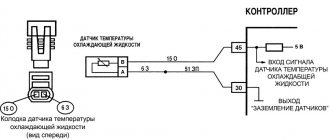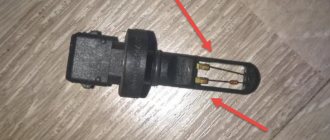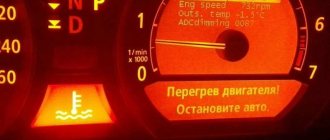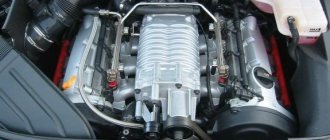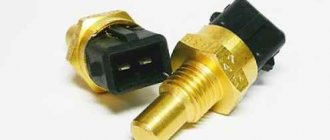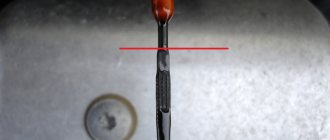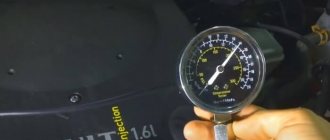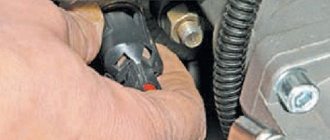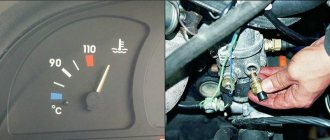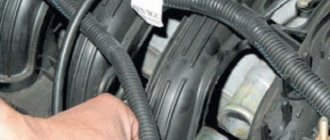Checking the coolant temperature sensor (CTS) is a work aimed at determining the performance of the unit and its ability to respond to changes in temperature conditions.
To complete the work, you can go in two ways: immediately dismantle the device or first carry out a check without removal.
When choosing the first option, you will need a regular wrench of the required size (usually “19”), but on some foreign cars - a 20, 21 or 22 socket.
First make sure that the DTOZh receives a voltage of 5V (from 5 to 12 on some models). If it fits, you can proceed with the rest of the test.
Below we will consider in detail all the diagnostic methods, the causes of sensor failure, features of its location and other features using the example of VAZ cars with 8 and 16 valves, Kalina, Gazelle, 2115, 2114, Renault Logan, Lada Priora and Chevrolet Niva. The methods described below are also suitable for most other brands of cars.
Design and principle of operation
The DTOZh temperature sensor is a resistor (thermistor) that reacts to the temperature of the antifreeze in the engine cooling system. Information about the resistance of this element is transmitted to the ECU, which decides to change the settings in the engine operation.
The information obtained is used by the ECU to determine the steps of the idle speed regulator to optimally adjust the required volume of the fuel mixture.
The peculiarity of DTOZH is that in the cold its resistance increases, and when heated, on the contrary, it decreases.
So, when reaching 130 degrees Celsius, the resistance parameter is 70 Ohms, and at minus 40 degrees - 100.7 kOhms.
The thermistor is controlled by applying +5 V voltage to it from the controller.
The potential passes through a classical resistor with constant resistance (R).
The antifreeze heating level is calculated based on the voltage drop across the DTOZh with variable R (Ohm). In this case, the drop will be large on a cold engine, and low on a warm engine.
Types of engine temperature sensors: what type is used on Priora
It is important to understand that there are two types of engine temperature sensors. They differ in the principle of operation, and you need to know the operating features in order not to make a mistake when choosing such an element for your car. The following types of DTOZH are distinguished:
- With a negative temperature coefficient
(NTC - negative temperature coefficient) - it works as follows: when the temperature rises, the resistance decreases, and vice versa. - With a positive coefficient
(PTC - positive temperature coefficient) - it has the opposite principle of operation. When the temperature increases, the resistance increases.
The most common types are negative temperature devices. It is these sensors that are used on Priora cars.
When the engine is cold, the maximum resistance of the Priora DTOZH thermistor reaches 100.7 kOhm (this value will be at a temperature of -40 degrees). When the engine warms up, the temperature increases, which means the resistance drops. At a high temperature of +130 degrees, the thermistor resistance is about 70 Ohms. These readings are the operating range. When the engine is cold, the voltage drop in the circuit will be large (drops to 18%). As it warms up, it will increase (up to 90%).
Where is
To check the DTOZH, you need to know its location. Please note that the location of the sensor may vary depending on the make/model of the machine.
Most often, the thermistor is mounted between the cylinder head and the thermostat or on the coolant outlet pipe.
But on some cars it is installed on the radiator pipe.
Externally, the device looks like a small element with a thread, with which the DTOZH is screwed into a special hole. In this case, the regulating element itself is located in the antifreeze and controls its temperature.
In certain cars, for example, the BMW E39, there may be two DTOZH. One controls the heating of the antifreeze and is installed at the outlet of the engine, and the second is located behind the radiator. To remove you will need a 22 key.
This type of installation allows you to control the temperature in different areas and thereby take action faster.
Note that two sensors are installed on powerful / expensive cars, where the temperature parameter is of key importance.
In this case, the control unit must have appropriate programs. For more information, please refer to your vehicle's manual.
Functionally, the sensor is very reliable and breaks down in rare cases. Most often it shows false information. Sometimes other damage is possible, for example, chafing of wires or poor contact quality.
As for the features of the location of the DTOZH on different models, we will dwell on this issue below.
Cabin temperature sensor
To control the heating system of the VAZ 2110, a cabin temperature sensor - DTVS is used. Based on its readings, the controller adjusts the position of the heater valve and the fan rotation speed, supplying cold or hot air to the machine. The sensor is located in the middle of the ceiling panel, behind the central lamp. The sensor consists of a thermoelement and a microfan installed in a rectangular plastic housing.
Replacing the temperature sensor with your own hands is quite simple: you need to carefully pry off the retaining latches with a screwdriver, lower the sensor and disconnect the wire block. The new device is installed in the reverse order. Catalog number of the original part: 2110-8128050-02, its average cost is about 800 rubles.
If, after installing a new sensor, inconsistencies arise between the mode selected on the climate control unit and the actual temperature in the cabin, then adjustments should be made. To do this, you need to remove the heater control unit from the panel and turn the adjusting screw on the left side of the case (to increase the temperature - clockwise, to decrease - in the opposite direction).
Symptoms of a problem
To take measures to control the coolant temperature sensor, it is necessary to identify problems in this unit in time.
But it is worth considering that the signs discussed below may indicate other malfunctions of the power unit.
This is why additional diagnostics may be required to obtain an accurate result.
It is also important to understand what part the DTOZH takes in the operation of the engine:
- Informs the driver in real time about the coolant temperature.
- When the engine reaches a threshold temperature value, the ECU, having received information from the coolant sensor, turns on the forced cooling fan, as a rule, this is about 100 0C.
- Participates in the process of increasing idle speed by enriching the fuel-air mixture on a cold engine.
- When the car is moving, the ECU generates general information about the operation of all systems based on the data received from the sensors and, based on this data, forms the correct fuel-air mixture. The coolant temperature sensor also takes part in this process.
Primary symptoms of failure:
- The Check Engine light on the dashboard comes on. To obtain more accurate information, it is better to scan the ECU and look for errors, for example, through an ELM327 auto scanner connected to a smartphone. See error codes below.
- The engine starts and immediately stalls.
- Malfunction of the fan in the radiator. The malfunction may manifest itself as a refusal to turn on when it heats up or operation even after the motor has cooled down. When the DTOZ is turned off, the electronic control unit of the machine perceives the problem as a break and turns on the fan.
- The appearance of dark or gray-black smoke from the exhaust pipe.
- Increased "gluttony" of the car. This is due to the fact that incorrect information is supplied to the ECU. Accordingly, the “brains” of the machine cannot determine the volume of displacement required to maintain optimal temperature conditions.
- Antifreeze leaking from under the DTOZh housing. This problem can be determined by visual inspection.
- A hot engine stalls. The problem may occur when the maximum temperature is reached. In this case, the type of coolant filled does not matter.
- The power unit heating indicator on the dashboard does not work.
- Engine malfunctions. The problem may manifest itself as stopping at low speeds, difficulties starting in winter, hesitation when operating at idle, etc.
- The coolant boils, but the instrument panel displays the temperature within normal limits.
- Increased engine heating time, etc.
The problems discussed above can occur one at a time or in combination, but in most cases they indicate a malfunction of the power unit. However, the antifreeze temperature sensor is not always the main cause of the malfunction.
CO functions
The cooling system is responsible for removing excess heat that is generated during operation of the power unit. If the engine overheats, the consequences can be catastrophic.
Cooling system diagram
In addition to heat removal, CO additionally performs several other functions:
- Helps accelerate engine warming up to optimal operating temperature;
- Warms the air inside the cabin;
- Cools the lubrication system;
- Cools exhaust gases.
In total, three types of cooling systems can be used on cars:
- Air. The cooling process is carried out by blowing air over the units;
- Liquid. The coolant is a special liquid - water, antifreeze or antifreeze;
- Combined. Both types of cooling are mixed in one system.
antifreeze or antifreeze acts as a cooler .
How to check without removing it from the car
If you suspect a faulty DTOZH, it is not necessary to remove it from the car. All manipulations can be done without dismantling using a tester or diagnostic device. Let's consider each of the methods in more detail.
Pre-check
To check the temperature meter, start the car and let the engine warm up at idle to 90 - 95 0C.
Disconnect the connector from the sensor and notice how the arrow on the instrument panel behaves:
- if the arrow remains in place, then you need to check the meter itself or the electrical circuit going to the device (more on this later);
- if the arrow goes down, then check the fuse. If it is intact, and when the contact is shorted to ground, the arrow jumps, then the sensor is faulty.
Multimeter
The simplest method to check the coolant temperature sensor is to use a tester.
First, we check the voltage; for this, set the multimeter to the “Measure constant voltage up to 20V” mode.
- Disconnect the connector from the meter.
- Turn on the ignition.
- Connect the positive wire of the device to the “+” connector, and short the second contact of the tester to the motor. The device should show between 4.8 and 5.2 V.
When working on a hot engine, be careful not to touch the metal surface, so as not to burn yourself and damage the measuring device.
The algorithm of actions is as follows:
- Discard the contacts from the sensor.
- Set the resistance measurement mode on the multimeter.
- Measure the parameter between the terminals.
- Compare them with the tabular data that can be found in your vehicle's repair and maintenance manual.
On some car models, it is very difficult to get to the sensor connectors and you will have to remove it.
To minimize antifreeze losses, unscrew the expansion tank cap to relieve pressure in the system. Then tighten the plug again.
Exact resistance specifications may vary depending on model.
As an example, we give several resistance parameters for a VAZ 2110 car.
Table 1.
| Temperature 0C | Ohm resistance |
| +100 | 177 |
| +80 | 332 |
| +60 | 677 |
| +40 | 1459 |
| +20 | 3520 |
| +10 | 5670 |
| +5 | 7280 |
If the DTOZH produces erroneous information, it may need to be removed for a more detailed check, and subsequently replaced.
Diagnostic tool
If an engine error appears on the dashboard, it is worth checking the ECU for errors related to the temperature sensor.
The most convenient option is to use an ODB2 scanner. To avoid high costs, you can use a simple model of Scan Tool Pro Black Edition or ELM327, which we wrote about above.
The general algorithm of actions is as follows:
- Inspect the DTOZH for damage to the wires or the appearance of rust.
- Connect the device and read the errors (see the link above for how to do this).
- Codes P0115, P0117. P0116 or P0118 indicate the presence of malfunctions in the functioning of the sensor.
The capabilities of the model discussed above allow you to look at the operation of the sensor online, as well as look at the functioning of other components: gearbox, transmission, ESP, ABS and others.
The device works with all diagnostic software and works without loss of communication. Bluetooth and Wi-Fi are used for communication.
Video - Methods for checking the coolant temperature sensor
There are actually not many verification methods, but all of them will give the most accurate result. The first assumes the most normal operating mode. The sensor must turn on the fan when the response temperature is reached. If the fan does not start, the wires from the sensor are pulled out and shorted together. Successful start of the fan will directly indicate a malfunction of the device. If the fan still refuses to rotate, then the failure is hidden in the fan itself.
The second method can determine the condition of the new sensor. To do this, you can boil water in a saucepan and dip the working part of the sensor into it (but not the head). First, connect the wires to it and connect the battery and the lamp in series. If the lamp lights up, the sensor is triggered successfully. If not, or the lamp lights up even if it is not heated, then the sensor is faulty and needs to be replaced.
These are the most basic methods. They are accessible to any driver and can be performed without the help of third-party tools or special knowledge.
Checking the removed DTOZH
For a more accurate check, it is recommended to remove the device from the vehicle. To do this, you need to let the engine cool, and then drain the coolant from the system.
To remove it, you only need a key “19” (20, 21, 22), with which you can unscrew the sensor and remove it together with the ring.
At the same stage, it is worth assessing the condition of the device itself, its threads, cleaning and lubricating it.
The same operations can be done with respect to the sensor itself. After dismantling is completed, you can proceed directly to work.
Checking with a thermometer
After dismantling, you can check with a thermometer. This option provides the most accurate information, so it is recommended for most cases.
The algorithm of actions is as follows:
- Prepare a vessel and pour water into it.
- Use a boiler to heat water.
- Prepare your multimeter for measurements.
- Immerse the sensor element in the liquid.
- Provide the ability to connect a multimeter to the contacts.
- Place a thermometer in the water to monitor the temperature. It is better to use the electronic version, which provides greater accuracy.
- Heat the water and take measurements for different temperatures, for example, from +5 degrees Celsius and above in steps of “5”.
- Fill out the table containing the resistance parameters in relation to the set temperature.
- Check with the information provided in the vehicle manual.
Of course, inaccuracies may occur during the measurement process. The error depends on several factors: operating conditions and the characteristics of a particular DTOZH. In particular, even in devices of the same model, the resistance parameter may differ.
Without thermometer
If desired, checks can be made without using a water temperature meter.
In this method, you can act according to the principle discussed above, but with minor restrictions.
The general algorithm is:
- Boil the water.
- Install the DTOZh sensitive element into it.
- Measure the resistance at the terminals.
At a temperature of about 100 degrees Celsius, the resistance should be about 177 ohms. But here you need to take into account possible errors.
In particular, at the time of measurements, the temperature may change downward.
The disadvantage of the method is that the test is performed only at one temperature point.
Replacing the antifreeze sensor on a VAZ 2107
First of all, it should be said that the temperature sensors on the VAZ 2107 cannot be repaired. The reason is simple: this device does not contain parts and materials that the driver could purchase and replace himself. In addition, the body of the temperature sensor is not dismountable, so it is simply impossible to get to the insides of this device without breaking it. Here's what you need to replace it:
- new temperature sensor VAZ 2107;
- 30mm socket with a long wrench (or a regular spark plug wrench);
- container for draining coolant.
Sequence of operations
- The car is placed on a viewing hole or on an overpass. Place a container under the drain hole, unscrew the plug, and drain the antifreeze.
A small basin is ideal for draining antifreeze from a VAZ 2107 - The contact wires are removed from the sensor. They must be carefully pulled towards you.
The red arrow shows the contact cap of the VAZ 2107 sensor - The sensor is unscrewed with a socket by 30 (remember that under the sensor there is a very thin o-ring that can be easily lost).
- A new one is screwed in place of the unscrewed sensor (and when screwing in a new sensor, you should not use too much force, especially if the driver of the socket head is very long: the thread in the sensor socket is easily torn off).
- The cap with the contact wires is put back on the sensor, and new antifreeze is poured into the expansion tank.
Video: replacing the coolant sensor on a VAZ 2107
Features of checking for VAZ 2110
The “tens” configuration includes two types of engines – 8 and 16 valves. But the features of the DTOZH, location and replacement are identical.
On these VAZ 2110 you can use the Lusar LS 0101 temperature sensor. The car has two coolant temperature meters installed, one near the thermostat and it interacts with the computer, the second on the radiator and transmits data to the instrument panel.
The procedure for checking is the same; resistances at different temperatures are shown in Table 1.
Typical signs of DTOZh failure
After some time, all malfunctions that occur in the circuit are entered by the controller in the form of a code into the ECU memory.
A signal about engine malfunctions is sent to the instrument panel in the form of a lit “CHECK ENGINE” indicator light.
Signs of a faulty meter on a VAZ 2114:
- turning on the fan when the engine is cold;
- fuel consumption increases;
- There are problems starting a warm engine.
Main faults:
- lack of contact with the device;
- rupture of contacts, violation of insulation;
- sensor failure;
- The fan does not work when needed.
Before changing the DTOZH on a VAZ 2114, you need to make sure that this is the cause of the problem. The malfunction may be caused by a broken fuse or a faulty fan.
VAZ 2114, VAZ 2115
On these cars, GM 2112-3851010-01 can be used as a DTOZH. The location of the device is between the cylinder head and the thermostat.
To check, it is recommended to dismantle the element (open-end wrench size 19). To do this, you need to wait until the engine cools down, reset the negative voltage on the battery and drain the antifreeze.
After this, you need to dismantle the device and check it by heating the liquid, a thermometer and a multimeter.
The following parameters must be present.
Table 2.
| Temperature, 0C | Resistance, Ohm | Voltage, V |
| +30 | 1350-1880 | 8 |
| +50 | 585-820 | 7,6 |
| +70 | 280-390 | 6,85 |
| +90 | 155-196 | 5,6 |
| +110 | 87-109 | 4,7 |
If there is a discrepancy in the readings, the device must be replaced.
Features of the operation of the heat meter of the cooling solution VAZ 2114, 2113, 2115
The ECU sends a 5 V consumption voltage to the heat sensor of the cooling solution model 2112-3851010 through a resistor with stable electrical resistance located deep in the computer. Based on the change in voltage on the heat sensor of the cooling solution, the ECU determines the degree of heating of the propulsion cooling solution. The voltage drop is relatively large on a cold engine and small on a hot one. The degree of heat of the cooling fluid is used in most propulsion control options.
If a breakdown occurs in the connections of the heat sensor of the cooling solution, the computer enters it into its memory as code 14 or 15 and turns on the “CHECK ENGINE” signal light, notifying about the presence of a breakdown. In this case, the computer determines the amount of heat from the cooling moisture based on the duration of the engine’s activity.
Gazelle (engines ZMZ 406, 405, 409)
Installation location - on the power unit in the area of the thermostat or on the body of the latter.
To remove it, it is necessary to partially drain the coolant from the engine, disconnect the spring clamp of the harness block and discard the block from the sensor.
Next, using a key set to “19” you need to loosen the broach and unscrew the device.
When choosing a device, you need to focus on the engine and ECU.
406 engine and ECU Mikas 7.1, 5.4, SOATE, VS5.6
In such cases, a DTOZH is used, operating at a voltage of 5 to 12 Volts through a resistance of 9.1 kOhm.
Several types of devices are suitable for replacement: Kaluga 19.3828, Luzar LS 0306, Rikor 40.5226 or Autotrade 42.3828.
When checking, you will also need water with a boiler and variable temperature, as well as a multimeter.
To work, you need to assemble a circuit and apply 1 to 1.5 mA to it. In this case, it is necessary to measure not resistance, but voltage.
When checking, the following parameters must be present:
- -60 0С - 2.13 V;
- -40 0C - 2.33 V;
- -20 0C - 2.53 V;
- 0 0C - 2.73 V;
- +40 0С - 3.13 V;
- +80 0С - 3.53 V;
- 105 0C - 3.83 V;
- 125 0C - 3.98 V.
When the engine is running, the voltage will be 5 V.
Engine 405, 409, UMZ 4216E3, 4213 control unit Mikas 11 / 10.3, VS8, SOATE
DTOZH with catalog numbers 234.3828, 40.5215 or 421.3828 are used here.
Unlike the method discussed above, here it is necessary to measure resistance.
In this case, the dependence should be as follows:
- 128 0C - 80.8 Ohm;
- 100 0С - 177 Ohm;
- 80 0С - 332 Ohm;
- 60 0С - 667 Ohm;
- 40 0С - 1459 Ohm;
- 20 0С - 3520 Ohm;
- 0 0С - 9420 Ohm;
- -20 0С - 28680 Ohm;
- -40 0С - 100707 Ohm.
In case of significant deviations from these parameters, the device must be replaced.
Possible malfunctions and ways to eliminate them
The following symptoms may inform the car owner about the failure of the DVT:
- The quality of the exhaust gases is too low, which is associated with a violation of the combustible mixture in the cylinders.
- Fuel consumption has increased, and noticeably.
- Problems have arisen in the operation of the power unit. The dynamics of the vehicle may decrease, and the engine power as a whole will also deteriorate.
- Combinations of errors may appear on the dashboard, and the ECU may also send a signal to the dashboard about the need to check the performance of the motor.
- The power unit has become more difficult to start.
When they detect the first signs of problems, many motorists immediately drive their car into a garage or service station to change the controller. In practice, symptoms of DTOZ malfunctions are often associated with damage to the electrical circuit and poor contact of the device with the vehicle’s on-board network. Therefore, if you encounter a similar problem, we first recommend checking the condition of the wiring.
Photo gallery “Diagnostics of DTOZH”
1. DTOZH connected to a multimeter in a container with antifreeze
2. Dependence of temperature (left), resistance (right)
Niva Chevrolet
For installation, you can use DTOZH 2112-3851010 Kaluga (23.3828). It is difficult to visually determine the location of the device, because it is covered by other parts.
After removing them, you can see that the device is located in the upper part of the thermostat in the hole in the front pipe of the water jacket (the one that goes into the cylinder block). After unscrewing it (snap on 19), antifreeze does not flow.
The check is carried out according to the same schemes as discussed above. In this case, you need to have before your eyes a table with the parameters of temperature and resistance of the DTOZH.
Table 3.
| Temperature, 0C | Resistance, Ohm |
| +100 | 177 |
| +90 | 241 |
| +80 | 332 |
| +70 | 467 |
| +60 | 667 |
| +50 | 973 |
| +45 | 1188 |
| +40 | 1459 |
| +35 | 1802 |
| +30 | 2238 |
| +25 | 2796 |
| +20 | 3520 |
| +15 | 4450 |
| +10 | 5670 |
| +5 | 7280 |
| 0 | 9420 |
| -4 | 12300 |
| -10 | 16180 |
| -15 | 21450 |
| -20 | 28680 |
| -30 | 52700 |
| -40 | 100700 |
Also on the Chevrolet Niva, in the area of the 4th spark plug, there is a DUTOZH (coolant temperature indicating sensor), which displays data on the instrument panel; it does not transmit information to the ECU and does not affect the operation of the engine.
But it can provide incorrect data to the instrument panel and mislead the driver.
You can unscrew it without draining the coolant, but before doing this, relieve the pressure in the system by unscrewing the cap of the expansion tank.
It is also checked by comparing the temperature with the readings of the multimeter.
See table below.
How to check
There are two options for checking the functionality of the sensor:
- With the need to remove;
- With thermometer;
- Without thermometer;
- Right on the spot, without taking off.
But first you need to make sure that the sensor is receiving power. Remove the chip from the DTOZH and measure the DC voltage with a multimeter. It should be about 5 V. If it is approximately within these limits, we check further.
Without removing the sensor, you can check its performance in the following way. We disconnect the chip. We measure the resistance between the sensor contacts. When the engine is cold, the resistance will be higher, and when the engine is hot, it will be lower. For example, let's give a data table for the VAZ-2110 car. For other cars that use similar sensors, the numbers will be approximately the same.
| Water temperature, °C | Resistance value, Ohm | Water temperature, °C | Resistance value, Ohm |
| +5 | 7280 | +45 | 1188 |
| +10 | 5670 | +50 | 973 |
| +15 | 4450 | +60 | 667 |
| +20 | 3520 | +70 | 467 |
| +25 | 2796 | +80 | 332 |
| +30 | 2238 | +90 | 241 |
| +40 | 1459 | +100 | 177 |
Kalina
The official version of the DTOZH for the VAZ 2112 is 2112-3851010. But you can use analogues, for example, ERA (33026), Luzar (LS 0112), Fenox (TSN 2211207).
The location of the sensor on a car with an 8- and 16-valve engine is near the thermostat. In this case, the device is slightly closed by the filter housing.
In this case, on the Lada Kalina 1 you will have to remove the air filter to access the temperature meter.
To unscrew, use a 19 key. There is no need to drain the antifreeze.
Check, as in the previous case, after removing the device with the key to “19”.
For temperature and resistance readings, see Table 3.
Checking the presence of operating voltage is carried out with a multimeter with the ignition on without removing the sensor between the block terminal “B” and ground (there are two terminals on the blocks “A” and “B”), standard readings are within 4.8-5.2 V.
Replacement
The check showed that the sensor was to blame. Therefore, you have no choice but to replace it with a new one. For this:
- The coolant is drained. It is better to drain the maximum amount. Especially if the coolant has long been due for replacement;
- Disconnect the terminals from the battery;
- To make it more convenient to work, remove the air filter from its seat;
- Turn off the ignition and remove the sensor connector;
- Use a 19mm wrench to remove the sensor. The sealing ring must be removed along with it;
- A new seal ring is taken and a new, high-quality coolant sensor, suitable for the VAZ 2110 model, is mounted in place of the old one;
- The entire assembly process is performed in reverse order.
The coolant temperature sensor for the VAZ 2110 plays an important role. The owners of this model know very well that its failure is not a rare situation. The good news is that the replacement procedure is not complicated and can be carried out by any driver, even whose driving experience does not exceed several days.
As for the cost of self-repair, you only need to purchase a new O-ring and the sensor itself, of course. Today, a good quality device for a “ten” costs about 200 rubles. The tools are only the most standard ones, so you won’t have to buy anything or spend any extra money.
A professional will do the work at the auto repair shop, but the cost of the repair will be appropriate. Plus, many service stations use cunning moves, trying to force the car owner to perform a number of additional measures. Sometimes they are really useful, but sometimes they are just an attempt to get more money out of you.
Decide for yourself whether it’s worth taking the car to a service center to replace the TOZ sensor, or whether you can calmly complete the entire procedure yourself in an hour, but save a decent amount of money.
Renault Logan
On Renault Logan you can use many types of DTOZH, for example, MEAT & DORIA 82187, JP GROUP 1293102400, Vernet WS2602 and others.
Originals:
- 12-RENAULT-7700101968 (triangle contacts) - installed on 8 valve engines until 2012.
- 12-RENAULT-226307034R – after 2012 (contacts in a row).
All of them are suitable for K4M and K7M motors, their locations vary.
So on the K4M (8 valves), the temperature meter is installed in the water distributor housing (in the cylinder block). He is alone, transmits information to the instrument panel and works in conjunction with the ECU.
On the K7M engine at the rear end of the cylinder head.
On the body of the block there are markings for the three terminals “A”, “B1” and “B2”. The operating voltage is measured, as in the case above, with the ignition on between terminal “B1” and ground. The norm is from 4.8 to 5.2 V.
If voltage is not supplied to the block, disconnect the wiring harness from the ECU and use a tester to check the wiring for an open circuit. We take measurements between “B1” and pin “13” of the ECU.
If the circuit is working, then the control unit has failed.
We switch the tester to the “Resistance measurement” mode and check for an open circuit in the “ground” circuit of the sensor between terminal “B2” and the body of the machine (engine).
Readings of less than 1 ohm indicate a healthy circuit. If the device shows infinity, then there is a break between terminals “73” of the ECU and “B2” of the block.
Next, if you don’t want to remove the coolant temperature sensor from the engine, use a tester to measure the resistance readings on a warm and cold engine between the sensor terminals “B1” and “B2”.
Normative data are shown in Table 4.
| Temperature, 0C | Resistance, Ohm |
| 120 | 105 |
| 110 | 135 |
| 90 | 240 (+/ — 30) |
| 80 | 335 (+/ — 35) |
| 50 | 810 |
| 25 | 2050 |
| 20 | 3500 (+/ — 500) |
| 4 | 7500 (+/ — 500) |
To further check the device, you can use one of the methods discussed above.
For greater reliability, it is advisable to dismantle the device; use a 21 head.
Coolant temperature sensor on Priora: technical parameters
The cost of DTOZh on Priora is about 200-400 rubles. Products are produced by different manufacturers, but the most popular are Luzar devices. The coolant temperature sensor on Priora has article number 23.3828.
It comes in a cardboard package along with an O-ring (copper or steel washer), which is important not to forget to put on the thread when installing. Below are the technical parameters of the sensor.
Before installing a new product, you can check it by measuring the resistance value. This will ensure that you have not purchased a defective product. How the replacement is performed is described in detail below.
Checking the thermistor for functionality
When the result of our work is already in front of us, we can check all the functionality and correctness of the readings. You can do this using:
- Thermometer.
- Containers with water.
- Ohmmeter.
- Tables of heat versus electrical resistance. The operation of the element is based on the principle of measuring resistance depending on temperature.
If the DTO readings of your VAZ 2114 differ from those presented below, then this element must be replaced. After all, it is almost impossible to repair the device. At twenty degrees the electrical resistance should be at 3520 Ohms, at forty degrees - 1459 Ohms, and with boiling water - 177 Ohms. If everything is in order, then the problem may lie somewhere else, like a thermostat.
How to remove and replace the coolant temperature sensor (fan on) on a Priora
The process of replacing the sensor is not complicated, but before implementing it, it is important to know the following: before unscrewing it, you should unscrew the cap of the expansion tank and relieve the pressure in the cooling system. After this, you can begin dismantling work, but it is also important to take into account that after unscrewing the product, antifreeze will flow out of the installation hole. According to the manual, it is recommended to drain antifreeze from the radiator in an amount of at least 1 liter, but practice shows that if you relieve the pressure in the system and quickly replace the device, a small amount of liquid will leak out.
The process of replacing DTOZH on Priora is carried out as follows:
- Disconnect the negative terminal from the battery. Why do this? Naturally, no one is going to short-circuit the contacts, and the likelihood that they will close when in contact with metal parts of the engine is extremely low. However, after removing the sensor, antifreeze may get on the chip, and if there is voltage on it (there is none when the ignition is off), the ECU may short out. And therefore, if you do not disconnect the terminal from the battery, then after removing the chip, move it to the side so as to eliminate the possibility of a short circuit. However, to reduce the risk, it is better to disconnect the terminal on the battery.
- To make work easier, it is recommended to remove the air purification filter housing.
- After draining at least 1 liter of liquid from the cooling system (if you decide to go the right way), you need to disconnect the power supply. To do this, you need to pull back the tongue and remove the chip.
- Unscrew the sensor with an open-end wrench to “19”, and if liquid leaks out of the hole, quickly install a new sensor in place, having previously prepared it.
- When installing, do not forget about the copper washer.
- Tighten the sensor with a force of 9.3-15 Nm using a torque wrench.
This completes the process of replacing the fan sensor on the Priora. All that remains is to reset the errors from the BC and make sure that the engine is working properly, as well as the absence of signs that forced you to check and replace the DTOZH.
Source
What temperature sensors are installed on the VAZ 2114
DTOZH is designed to monitor the temperature of antifreeze in the cooling system circuit of the power unit. After receiving data about the current “degree”, the ECU increases (lowers) the speed of the power unit in order to adjust the temperature.
The quality composition of the fuel mixture depends on the accuracy of the DTOZ readings. The service life of the sensor is unlimited, with the exception of mechanical damage or short circuit in the circuit.
Where it is located: the standard installation location is the outer part of the thermostat housing. The base is screwed into the thermostat body. Two power contacts are connected to the upper part for power supply from the on-board network.
- A melting element is installed inside the DTOZh base. As soon as the antifreeze degree reaches “90”, the contacts close and the on-board computer signals an error.
Next, the driver decides on the advisability of stopping the car immediately, carrying out preventive maintenance, or calling a tow truck.
Catalog articles, prices of temperature sensors for VAZ 2114:
Name Catalog item Price in rubles
| DTOZH (original), 8 valves, injector | 2115-3811053 | from 350 |
| DTNV (original) | 2115-3828210 2115-3828210-02 2115-3828210-03 | from 350 – 400 |
Location of temperature sensors
- One of them, DTOZH, is located on the cooling system pipe running from the block head to the thermostat. It sends signals to the computer's electronic control unit so that additional cooling (fan) is turned on in a timely manner. Don't look for it on the radiator; it was located there in previous models. Has two terminals. The DTOZh removed from the car looks like this:
Appearance of DTOZH
- The second sensor is called DTUOZH, it has one terminal and sends a signal to the dashboard in the cabin, where the driver sees the temperature of the coolant (not the engine, as many people mistakenly think). It is located, as can be seen from the first figure, on the engine block under the cooling system pipe. It may have a rubber cap that protects the terminal from moisture. DTUOZH looks like this:
Appearance of DTUOZH
